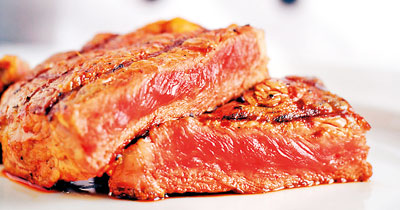When the food we eat makes us sick
The human body requires many important nutrients in order to receive energy to perform its daily tasks. Similar to a machine requiring fuel for optimum performance our body also must meet its requirements such as carbohydrates, proteins, lipids, vitamins and minerals in appropriate quantities. Though food strengthens our body, there are many instances when it can cause food poisoning.
 Food poisoning or in other words food-borne infections are due to consumption of food contaminated with infectious micro-organisms such as bacteria, fungi and viruses. There are various symptoms that occur due to food poisoning such as nausea, diarrhoea, vomiting, abdominal cramps, dehydration, bloating and fever.
Food poisoning or in other words food-borne infections are due to consumption of food contaminated with infectious micro-organisms such as bacteria, fungi and viruses. There are various symptoms that occur due to food poisoning such as nausea, diarrhoea, vomiting, abdominal cramps, dehydration, bloating and fever.
The number of bacterial cells residing in our body is basically larger than the number of cells in it. Scientists claim that 90% of the human body comprises microbial cells. But most of this micro biota are not harmful, they are favourable and provide numerous benefits. But some bacteria are considered pathogens since they possess the ability to cause diseases once they enter our body.
Bacterial species such as E.coli O157:H7, listeria sp., salmonella sp., staphylococcus sp., Norovirus, campylobacter sp. are some of the bacteria related to poisoning. In addition some fungi as well as moulds are causatives of poisoning.
Sometimes it is not the bacteria that causes poisoning but the toxins produced by these bacteria may cause the disease. In some instances both the bacterial cells as well as the toxins might be responsible.
 Recently many incidents have been reported in Sri Lanka of food poisoning. Most of the incidents were reported from garment factories. In some cases it takes a long period before symptoms begin. This might vary from hours to days depending on the incubation period of bacteria specific to the species. Bacteria possess the ability to reproduce and multiply inside the body. Once the threshold level is exceeded, infection occurs.
Recently many incidents have been reported in Sri Lanka of food poisoning. Most of the incidents were reported from garment factories. In some cases it takes a long period before symptoms begin. This might vary from hours to days depending on the incubation period of bacteria specific to the species. Bacteria possess the ability to reproduce and multiply inside the body. Once the threshold level is exceeded, infection occurs.
Sometimes food might contain toxins already produced by bacteria and large amount of cells, in such cases food poisoning occurs rapidly. Bacterial toxins vary depending on the species. They can be classified according to the damage they cause such as neurotoxins-toxins which harms the nervous system eg:- Clostridium botulinum, enterotoxins-toxins which harm the digestive system e.g ;- Vibrio cholerae, cytotoxins-toxins which harm the cells etc. These are basically exotoxins that is toxins which are produced as a part of their growth and metabolism. Some bacteria also produce endotoxins.
 It should be kept in mind that consuming contaminated water too may cause the infection.Bacillus cereus – the original source of this bacterium is soil. It mainly grows rapidly in cooked rice and pasta, meat products and vegetables. Symptoms may appear within 1-5 hours of consumption. General symptoms are nausea and diarrhoea.
It should be kept in mind that consuming contaminated water too may cause the infection.Bacillus cereus – the original source of this bacterium is soil. It mainly grows rapidly in cooked rice and pasta, meat products and vegetables. Symptoms may appear within 1-5 hours of consumption. General symptoms are nausea and diarrhoea.
Clostridium botulinum – the original source is soil again. Especially grows in faulty processed canned meat and vegetables, cured meat and raw fish. Symptoms might develop within 1-7 days of consumption.
The infection might affect vision, cause paralysis and in severe cases might be fatal. This is a rare species. Campylobacter jejuni – the original source is raw meat and poultry. Risk of infection might be caused by consuming undercooked meat and poultry, raw milk and cross contaminated food. Symptoms develop within 3-5 days of consumption. General symptoms are fever, severe pain and diarrhoea.
Escherichia coli (E- coli) – Some E- coli strains are very beneficial for man because they live symbiotically in the gut producing vitamins and preventing the colonization of other pathogens. But some strains such as E. coli O157:H7 are harmful once it exceeds the threshold level. It might enter the gut through consuming contaminated water, milk, inadequately cooked meat, cross contaminated food etc. General symptoms are inflammations and diarrhoea that may develop within 3- 4 days of consumption.
Listeria monocytogenes – can be found everywhere, enters the human body through soft cheese, pre packed salad, cooked chilled products. Symptoms are diarrhoea and headache. Staphylococcus aureus – specially found on the skin and nasal tract of animals and humans. Can be infected by consuming contaminated cured meat, milk products, un-refrigerated handled food. Symptoms are pain and diarrhoea that may develop within 2-6 hours of consumption.
Prevention
Maintaining proper hygiene helps in preventing contamination. Mainly washing hands properly before cooking and cleaning, especially when dealing with raw meat is important. Using clean utensils and dishes is vital, perishable food and leftovers must be refrigerated within 2 hours. It must be kept in mind that refrigeration doesn’t kill bacteria or pathogens, it only ceases the activity of microbes due to low temperature conditions.
Also when purchasing food items, make sure of the quality and hygiene of the place. Outdated foods, packaged food with broken seals or from damaged or bulging cans must not be consumed. Also drinking untreated water from wells and streams might be a causative.


